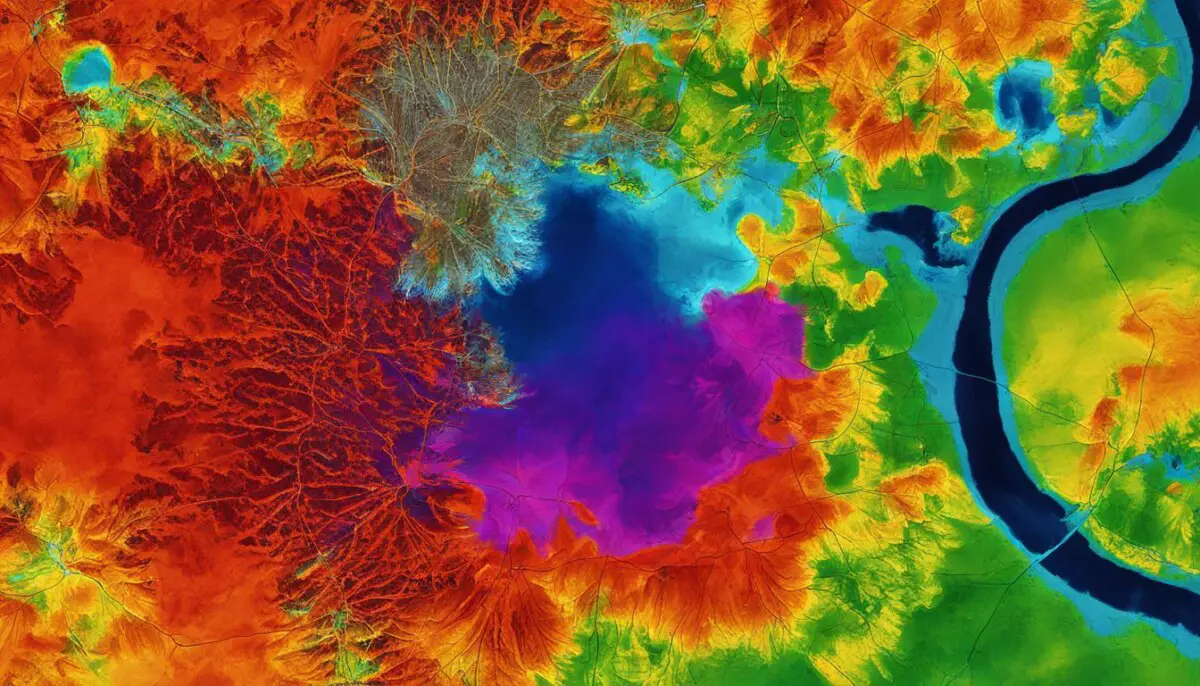Last Updated on 4 months by Francis
When it comes to remote sensing technologies, thermal and infrared cameras are often mentioned interchangeably. But are they really the same? Let’s explore the key differences between thermal and infrared remote sensing and how they are applied in various fields.
Firstly, it’s important to understand that while all thermal cameras are a type of infrared camera, not all infrared cameras are thermal cameras. Infrared cameras encompass a broader range and refer to any camera that can detect and capture infrared radiation. On the other hand, thermal cameras, also known as thermographic cameras, are specifically designed to capture and visualize heat or thermal energy emitted by objects. This distinction sets the foundation for their contrasting applications and functionalities.
In fields such as environmental monitoring and security surveillance, both thermal and infrared remote sensing play crucial roles. From detecting anomalies in electrical systems to monitoring wildlife and assessing water quality, these technologies provide valuable insights into our surroundings. By understanding the nuances and applications of thermal and infrared remote sensing, we can leverage their strengths effectively and make informed decisions in various industries.
Contents
Key Takeaways:
- Thermal cameras are a subset of infrared cameras, specifically designed to capture heat or thermal energy emitted by objects.
- Infrared cameras refer to any camera that can detect and capture infrared radiation and have a broader range of applications.
- Thermal and infrared remote sensing is used in diverse fields such as environmental monitoring and security surveillance.
- Understanding the differences and applications of these technologies is essential for maximizing their utility and value.
- Both thermal and infrared remote sensing offer valuable insights into our environment and contribute to various industries.
How do thermal cameras work?
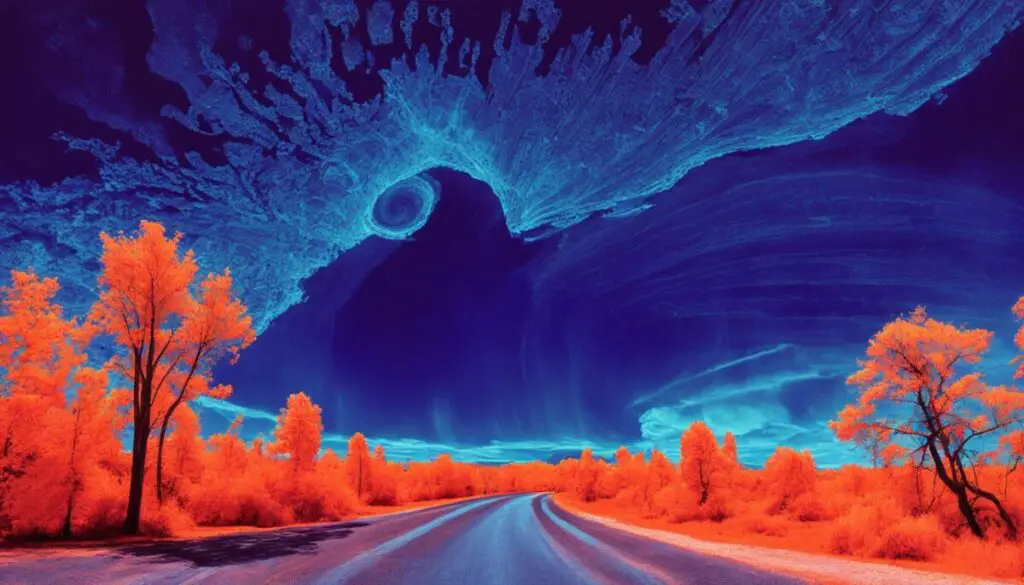
Thermal cameras use advanced technology to detect and capture infrared radiation emitted by objects. This process allows them to create thermal images that display heat distribution and temperature gradients.
Thermal camera technology involves several key components:
- Infrared Radiation Emission: Objects with a temperature above absolute zero emit infrared radiation.
- Microbolometer Sensor Array: Thermal cameras utilize a specialized sensor array called a microbolometer to detect and convert the emitted infrared radiation into an electrical signal.
- Signal Processing: The electrical signal generated by the microbolometer undergoes signal processing, which assigns temperature values to each pixel and creates a thermal image.
The resulting thermal image represents the heat signatures of the observed scene, enabling the identification of temperature variations and hotspots.
It’s important to note that thermal cameras operate in the infrared spectrum, not visible light. They rely on detecting emitted infrared radiation, which is invisible to the human eye, to capture and visualize heat.
To better understand the working principle of thermal cameras, take a look at the example thermal image below:
| Example Thermal Image | Description |
|---|---|
| This thermal image showcases the heat distribution and temperature gradients of a building. Warmer areas appear in red and orange hues, while cooler areas appear in blue and purple hues. |
How do infrared cameras work?
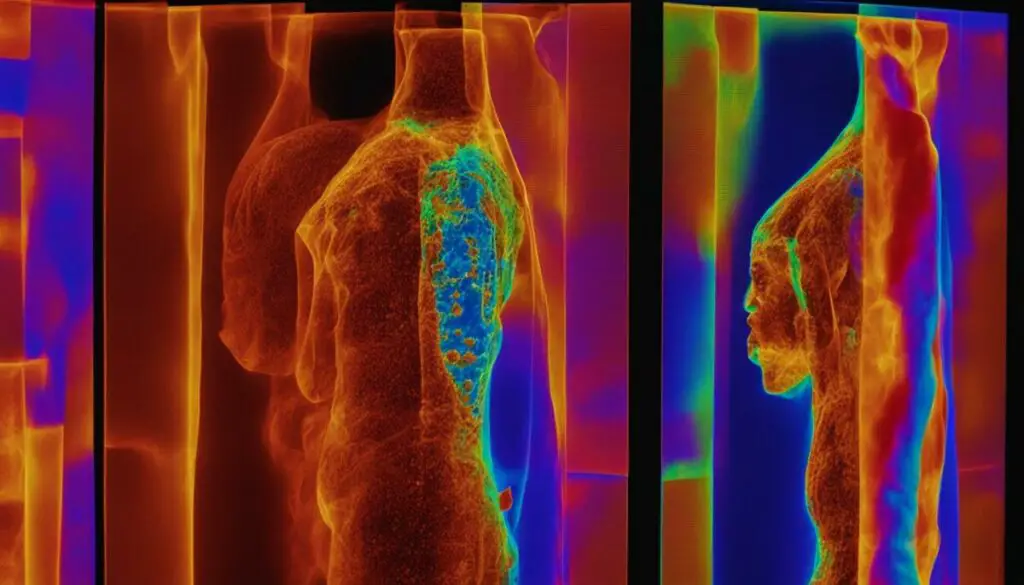
Infrared cameras, also known as IR cameras or thermal imaging cameras, work by detecting and capturing the infrared radiation emitted or reflected by objects. They utilize advanced infrared camera technology to enable the visualization of thermal energy, and the resulting infrared images offer valuable insights into temperature variations.
These cameras employ an infrared sensor or detector, such as a focal plane array (FPA), to measure the intensity of the infrared radiation. The sensor converts the detected infrared radiation into an electrical signal, which is then processed and analyzed to assign temperature values.
Infrared cameras primarily rely on the detection of emitted or reflected infrared radiation, rather than visible light. This unique feature allows them to capture and display the thermal profile of a scene, showcasing variations in heat distribution and temperature gradients.
By harnessing infrared camera technology, these devices excel in providing valuable information for various applications. In the field of night vision, infrared cameras enable clear visibility in complete darkness, facilitating enhanced surveillance and monitoring capabilities. In addition, their ability to detect heat signatures makes them a valuable tool in heat detection and surveillance tasks.
Moreover, the infrared imaging process employed by these cameras allows them to see through certain atmospheric obstructions, such as smoke, fog, and haze, thus delivering clear visuals even in challenging environmental conditions. This ability proves especially useful in applications such as search and rescue operations and firefighting.
In summary, infrared cameras utilize infrared camera technology to detect and capture emitted or reflected infrared radiation, enabling the creation of informative infrared images that provide valuable insights into temperature variations. With their ability to operate in darkness, detect heat signatures, and penetrate certain atmospheric obstructions, these cameras have a wide range of applications, including night vision, surveillance, and heat detection.
Advantages of Thermal and Infrared Security Cameras
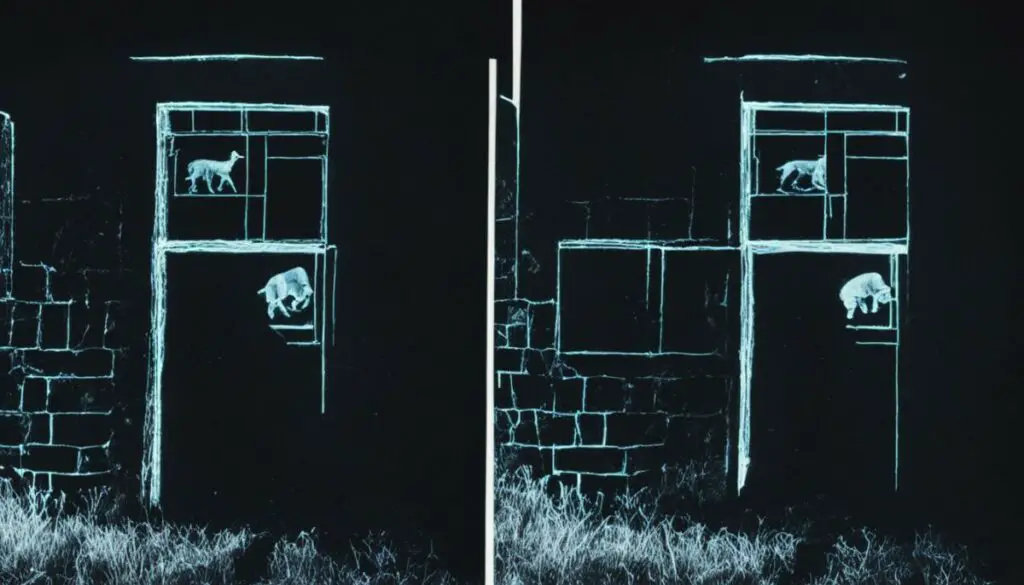
When it comes to security applications, thermal and infrared cameras offer numerous advantages over traditional surveillance systems. These advanced technologies utilize the power of heat detection and infrared imaging to provide clear visuals and enhanced threat detection capabilities. Let’s explore the key benefits of using thermal and infrared security cameras:
1. Operation in complete darkness or low visibility conditions
Unlike conventional cameras that rely on visible light, thermal and infrared cameras can effectively operate in complete darkness or low light conditions. By detecting and capturing heat signatures instead of relying on ambient lighting, these cameras ensure uninterrupted surveillance, making them perfect for night-time security.
2. Heat signature-based intrusion detection
One of the most significant advantages of thermal and infrared cameras is their ability to detect and capture heat signatures. By analyzing the thermal energy emitted by objects and individuals, these cameras can identify intruders based on their body heat, hence adding an extra layer of security to perimeter surveillance.
3. Clear visuals in challenging environments
Thermal and infrared cameras can see through obstacles such as smoke, fog, and even certain types of walls. This enables them to provide clear visuals even in challenging environments with limited visibility, ensuring critical details are captured and potential threats are detected.
4. Anomaly detection in electrical systems and machinery
Thermal and infrared cameras are not only limited to outdoor security applications. They can also be utilized to identify anomalies and detect potential threats in electrical systems, machinery, and HVAC systems. By monitoring temperature variations, these cameras can help prevent costly equipment failures, fire hazards, and efficiency issues.
With their unique capabilities, thermal and infrared security cameras offer an unparalleled level of surveillance and threat detection. Whether it’s monitoring perimeters, identifying intruders, or detecting anomalies, these advanced technologies provide an effective and reliable solution for enhancing security.
Applications of Thermal and Infrared Remote Sensing
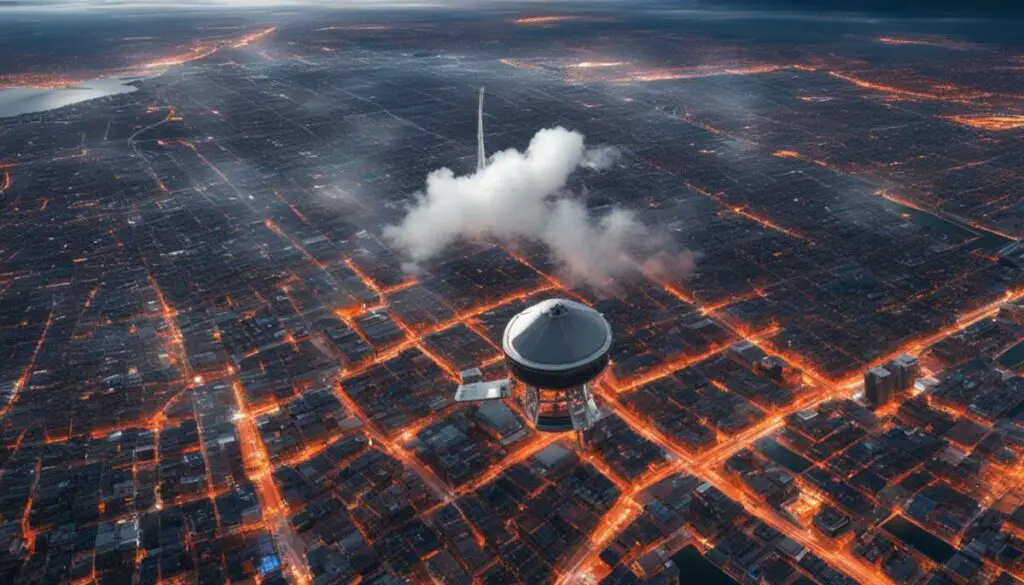
Thermal and infrared remote sensing technologies have revolutionized a wide range of industries with their diverse applications. These technologies have proven indispensable in various fields, including security, industrial processes, and most notably, environmental monitoring. Let’s explore the numerous uses and benefits of thermal and infrared technology.
Infrared Camera Applications:
- Night Vision: Infrared cameras enable clear visibility in low-light or complete darkness, making them an essential tool in military, law enforcement, and surveillance applications.
- Search and Rescue Operations: These cameras help locate missing persons or survivors in challenging environments by detecting body heat signatures.
- Medical Imaging: Infrared cameras aid in detecting health issues, such as inflammation and circulatory problems, by capturing thermal patterns in the human body.
- Industrial and Manufacturing Processes: Infrared cameras are used for quality control, monitoring machinery, identifying faulty components, and analyzing energy efficiency.
- Agriculture: Farmers utilize infrared cameras for crop health assessment, irrigation management, and pest control, improving overall agricultural productivity.
- Wildlife Monitoring: Infrared cameras facilitate the study of animal behavior, migration patterns, and population dynamics by capturing nighttime activities without disturbing natural habitats.
Thermal Camera Applications:
- Building Inspections: Thermal cameras help identify insulation issues, moisture intrusion, and electrical faults in buildings, ensuring energy efficiency and safety.
- Electrical and Mechanical Inspections: These cameras detect heat abnormalities, faulty connections, and equipment malfunctions in electrical systems and mechanical components.
- Firefighting: In firefighting operations, thermal cameras play a crucial role in locating hotspots, assessing fire spread, and aiding in victim rescue.
- Industrial Maintenance: Thermal cameras assist in predictive maintenance, identifying overheating equipment, and spotting leaks and blockages in pipelines.
- Veterinary Care: Thermal imaging allows veterinarians to identify inflammation, infections, and abnormal blood flow in animals, aiding in early diagnosis and treatment.
- Security Surveillance: Thermal cameras excel in detecting intruders by capturing heat signatures, enabling effective video surveillance even in low visibility conditions.
Environmental Monitoring:
Both thermal and infrared remote sensing technologies contribute significantly to environmental monitoring, providing valuable insights and aiding in critical decision-making processes. Here are some key applications:
- Monitoring Land Surface Temperature: Thermal and infrared sensors capture thermal variations to monitor temperature changes in land surfaces, assisting in climate studies and urban planning.
- Detecting and Mapping Wildfires: These technologies help identify active fire zones, track fire spread, and provide real-time data for firefighting efforts and ecosystem management.
- Monitoring Volcanic Activity: By detecting heat signatures and gas emissions, thermal and infrared remote sensing assist in monitoring volcanic eruptions, assessing volcanic hazards, and predicting volcanic activity.
- Assessing Water Quality and Pollution: These technologies aid in identifying and evaluating temperature anomalies, pollution sources, and water quality parameters in lakes, rivers, and oceans for effective environmental management.
- Thermal Infrared Spectroscopy for Environmental Analysis: Both thermal and infrared remote sensing enable the identification and characterization of minerals, vegetation types, and pollutants, contributing to geological surveys and environmental impact assessments.
| Application | Thermal Camera | Infrared Camera |
|---|---|---|
| Night Vision | No | Yes |
| Medical Imaging | No | Yes |
| Firefighting | Yes | Yes |
| Industrial Maintenance | Yes | No |
| Wildlife Monitoring | No | Yes |
Image Quality Difference between Thermal Cameras and Infrared Cameras
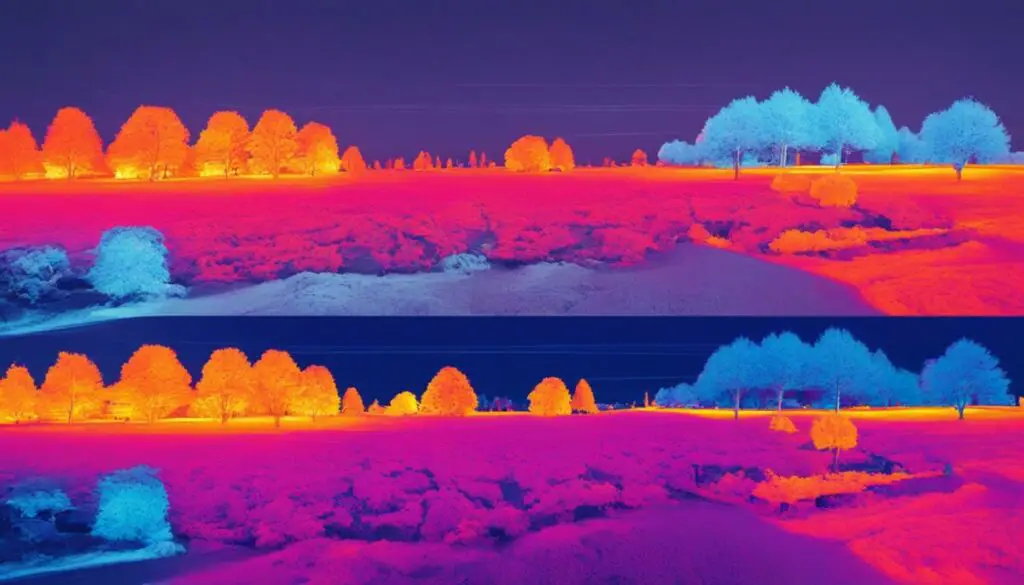
In the world of remote sensing, image quality is a crucial aspect that can significantly impact the effectiveness and accuracy of thermal and infrared cameras. Several factors come into play when comparing the image quality of these cameras, including resolution and sensitivity.
Resolution: Capturing the Finest Details
Resolution plays a vital role in the image quality of thermal and infrared cameras. It refers to the number of pixels or elements that make up an image, determining the level of detail and clarity. Higher resolution cameras have a greater number of pixels, which allows them to capture finer details in the scene being observed.
When comparing thermal and infrared cameras, higher resolution cameras tend to produce clearer and sharper images. This is particularly important when it comes to detecting small or subtle temperature variations in the environment. A higher resolution enables these cameras to identify and differentiate temperature differences more accurately, providing valuable insights and facilitating more precise analysis.
Sensitivity: Detecting Small Temperature Differences
Sensitivity is another critical factor influencing image quality in thermal and infrared cameras. It refers to the camera’s ability to detect and capture small temperature differences accurately. A camera with higher sensitivity can detect even the slightest variations in temperature, allowing for more precise thermal imaging.
Thermal and infrared cameras with higher sensitivity levels can identify and visualize temperature gradients and subtle differences in heat emission. This capability is particularly valuable in applications such as identifying anomalies in electrical systems, conducting building inspections, or detecting abnormalities in industrial machinery.
| Resolution | Sensitivity | |
|---|---|---|
| Thermal Cameras | High resolution allows for capturing finer details | High sensitivity enables detection of small temperature differences |
| Infrared Cameras | High resolution results in clearer and sharper images | High sensitivity enables visualization of subtle temperature variations |
By considering both resolution and sensitivity, it is possible to understand and evaluate the image quality differences between thermal and infrared cameras. It’s important to choose a camera that best suits the specific application and requirements, ensuring optimal image quality and accurate temperature measurements.
Advantages and Disadvantages of Thermal and Infrared Remote Sensing

Thermal and infrared remote sensing technologies offer a range of advantages that make them valuable tools in various industries. One of the key advantages is their ability to operate in darkness, providing effective surveillance and monitoring solutions in low-light conditions. Whether it’s security surveillance or search and rescue operations, thermal and infrared cameras can capture critical information and detect heat signatures that may not be visible to the naked eye.
Another major advantage is the ability of thermal and infrared cameras to see through obstructions such as smoke, fog, and foliage. This feature is particularly useful for applications like firefighting, where visibility can be severely hindered by dense smoke. By cutting through these obstacles, thermal and infrared cameras provide clear visuals and help guide firefighters to locate and combat fires more efficiently.
Furthermore, the capability of thermal and infrared cameras to detect heat signatures allows for precise identification and tracking of targets based on their body heat. This advantage makes them invaluable tools in security surveillance, enabling the identification of intruders or potential threats even in complete darkness.
“Thermal and infrared remote sensing technologies play a crucial role in environmental monitoring.”
However, it is essential to acknowledge the limitations and challenges associated with these technologies. Atmospheric effects can impact the accuracy of thermal and infrared remote sensing, as they can interfere with the propagation of infrared radiation. Additionally, variations in emissivity and surface heterogeneity can affect the temperature readings and image quality. Sensor saturation is another challenge that can occur when the infrared radiation levels are too high, resulting in distorted or unreliable data.
Another limitation is the spatial resolution of thermal and infrared cameras, which is generally lower compared to visible light cameras. This lower resolution may limit the ability to capture fine details and restrict the overall clarity of the images. Additionally, the availability of data can be a challenge, particularly in remote or inaccessible areas, affecting the frequency and coverage of monitoring activities.
Despite these limitations, understanding the advantages and disadvantages of thermal and infrared remote sensing is crucial for effectively utilizing and interpreting the collected data. These technologies continue to evolve, offering innovative solutions for a wide range of applications, from security to environmental monitoring.
| Advantages | Disadvantages |
|---|---|
| Ability to operate in darkness | Atmospheric effects |
| Ability to see through obstructions | Emissivity variations |
| Heat signature detection | Surface heterogeneity |
| Wide range of applications | Sensor saturation |
| Spatial resolution limitations | |
| Data availability challenges |
Overall, thermal and infrared remote sensing technologies offer unique advantages that can significantly enhance surveillance, monitoring, and analysis in various fields. However, it is essential to consider their limitations and overcome challenges to maximize their potential and extract accurate and meaningful insights.
Role of Thermal and Infrared Remote Sensing in Environmental Monitoring
Thermal and infrared remote sensing technologies play a crucial role in environmental monitoring, providing valuable information for a wide range of applications. By capturing and visualizing temperature variations, these technologies help scientists and researchers understand and monitor changes in the environment, contributing to the management and conservation of natural resources.
One of the key environmental applications of thermal and infrared remote sensing is monitoring land surface temperature. This allows for the assessment of heat distribution across different landscapes, which is essential for studying climate change, urban heat islands, and the impact of land-use patterns on temperature variation.
In addition, thermal and infrared remote sensing is instrumental in detecting and mapping wildfires. By identifying areas of intense heat and monitoring the spread of fires, these technologies enable timely and targeted firefighting efforts, reducing the damage caused by wildfires to ecosystems and human settlements.
Monitoring volcanic activity is another crucial application of thermal and infrared remote sensing. By detecting changes in volcanic heat signatures, scientists can anticipate eruptions, issue early warnings, and assess the impact of volcanic activity on surrounding areas, including the dispersion of volcanic ash and the formation of lava flows.
Thermal and infrared remote sensing also plays a significant role in assessing water quality and pollution. By analyzing thermal patterns in water bodies, scientists can identify areas of high temperature, which may indicate pollution sources such as industrial discharges or urban runoff. This data helps in monitoring and managing water resources, ensuring their sustainability and safeguarding aquatic ecosystems.
Furthermore, thermal infrared spectroscopy, a technique employed in thermal and infrared remote sensing, is used for environmental analysis. By measuring the emission and absorption of infrared radiation, scientists can analyze the composition of soils, minerals, and vegetation. This information is vital for various environmental studies, including mineral exploration, soil mapping, and vegetation health assessments.
| Applications of Thermal and Infrared Remote Sensing in Environmental Monitoring |
|---|
| Detecting and monitoring land surface temperature variations |
| Detecting and mapping wildfires |
| Monitoring volcanic activity |
| Assessing water quality and pollution |
| Conducting thermal infrared spectroscopy for environmental analysis |
By leveraging the capabilities of thermal and infrared remote sensing, scientists and researchers can gather critical data to gain insights into the environment, predict natural phenomena, and make informed decisions to ensure sustainable management and conservation of our planet.
Conclusion
In conclusion, thermal and infrared remote sensing technologies are closely related but have distinct characteristics. While thermal cameras are a subset of infrared cameras, they are specifically designed to capture and visualize heat or thermal energy emitted by objects. On the other hand, infrared cameras refer to any camera that can detect and capture infrared radiation.
Both thermal and infrared remote sensing offer unique advantages in various fields. They find applications in security surveillance, environmental monitoring, industrial processes, and more. Thermal and infrared cameras can operate in complete darkness, see through obstructions like smoke or fog, and detect heat signatures, making them invaluable tools in fields such as perimeter security and wildlife monitoring.
Understanding the similarities and differences between thermal and infrared remote sensing technology is crucial for using them effectively. By harnessing the valuable data they provide, professionals can make informed decisions, detect anomalies, and monitor changes in the environment. Whether it’s for ensuring security, managing natural resources, or analyzing industrial processes, thermal and infrared remote sensing technologies offer valuable insights and contribute to a wide range of applications.
FAQ
Are thermal and infrared remote sensing the same?
While thermal cameras are a type of infrared camera, not all infrared cameras are thermal cameras. Thermal remote sensing specifically captures and visualizes heat or thermal energy emitted by objects, while infrared remote sensing refers to any camera that can detect and capture infrared radiation.
How do thermal cameras work?
Thermal cameras work by detecting and capturing the infrared radiation emitted by objects. This is achieved through the emission of infrared radiation by objects with a temperature above absolute zero, the use of a microbolometer sensor array to detect and convert the infrared radiation into an electrical signal, and signal processing to create a thermal image representing the heat distribution and temperature gradients of the scene.
How do infrared cameras work?
Infrared cameras work by detecting and capturing the infrared radiation emitted or reflected by objects. They use an infrared sensor or detector, such as a focal plane array (FPA), to measure the intensity of the infrared radiation and convert it into an electrical signal. This signal is processed and analyzed to create an infrared image representing the thermal profile of the scene.
What are the advantages of thermal and infrared security cameras?
Thermal and infrared security cameras can operate in darkness or low visibility conditions, making them effective for surveillance at night. They can also see through smoke, fog, and other obstructions, providing clear visuals in challenging environments. Additionally, they can detect heat signatures, allowing them to identify intruders based on body heat and identify anomalies in electrical systems, machinery, and HVAC systems.
What are the applications of thermal and infrared remote sensing?
Thermal and infrared remote sensing technologies have various applications. Infrared cameras are used for night vision, surveillance, search and rescue operations, medical imaging, industrial processes, agriculture, and wildlife monitoring. Thermal cameras are used for building inspections, electrical and mechanical inspections, firefighting, industrial maintenance, veterinary care, and security surveillance. Both technologies play a crucial role in environmental monitoring, such as monitoring land surface temperature, detecting and mapping wildfires, assessing water quality and pollution, and conducting thermal infrared spectroscopy for environmental analysis and mineral exploration.
How do thermal and infrared cameras differ in image quality?
The image quality of thermal and infrared cameras can vary based on factors such as resolution and sensitivity. Higher resolution cameras capture more detail, resulting in clearer and sharper images. Sensitivity refers to the camera’s ability to detect and capture small temperature differences accurately. Both resolution and sensitivity affect image quality, and the performance of thermal and infrared cameras can vary based on these factors.
What are the advantages and disadvantages of thermal and infrared remote sensing?
The advantages of thermal and infrared remote sensing include their ability to operate in darkness, see through obstructions, and detect heat signatures. They have diverse applications and provide valuable data for environmental monitoring. However, challenges include atmospheric effects, emissivity variations, surface heterogeneity, sensor saturation, spatial resolution, and data availability.
What is the role of thermal and infrared remote sensing in environmental monitoring?
Thermal and infrared remote sensing plays a vital role in environmental monitoring. These technologies provide valuable information for monitoring land surface temperature, detecting and mapping wildfires, monitoring volcanic activity, assessing water quality and pollution, and conducting thermal infrared spectroscopy for environmental analysis. They help scientists and researchers understand and monitor changes in the environment, contributing to the management and conservation of natural resources.
How do thermal and infrared remote sensing differ?
Thermal and infrared remote sensing technologies are distinct but interconnected. Thermal cameras are a type of infrared camera, but not all infrared cameras are thermal cameras. Both technologies offer unique advantages and have diverse applications in fields such as security, environmental monitoring, and industrial processes.

